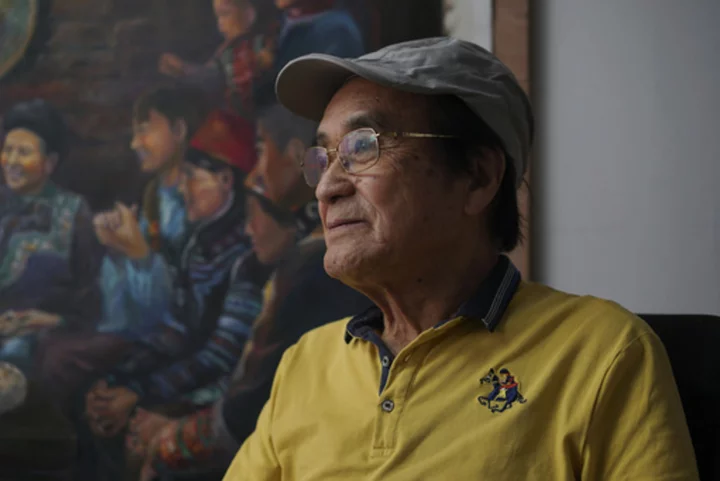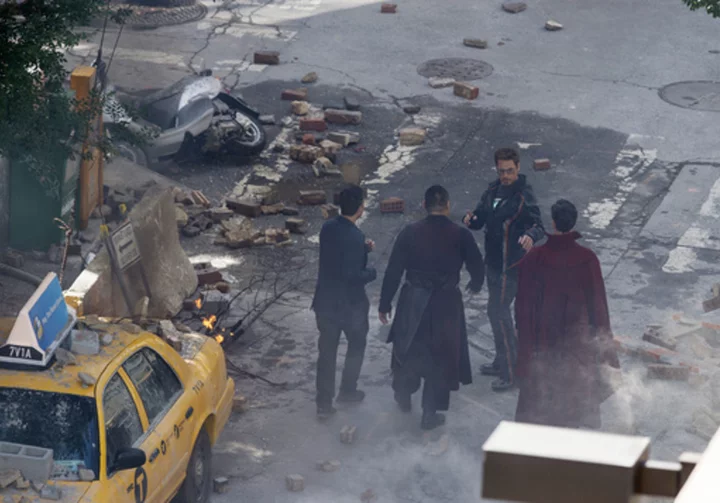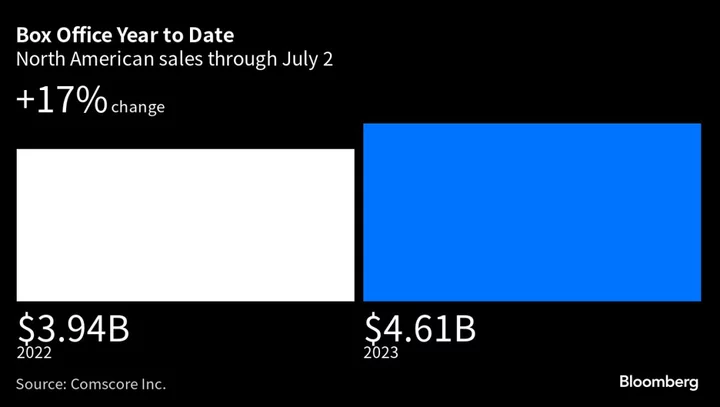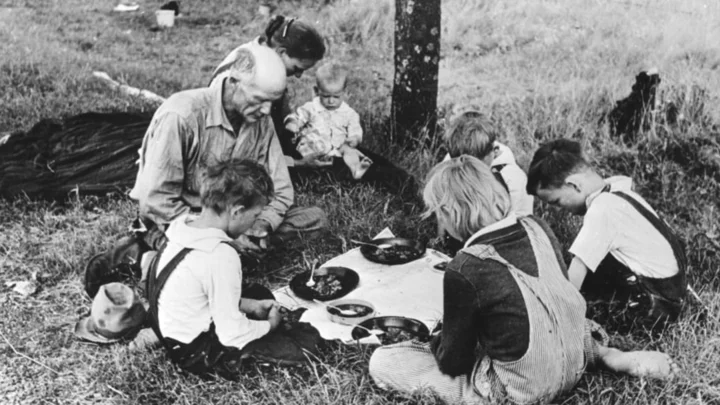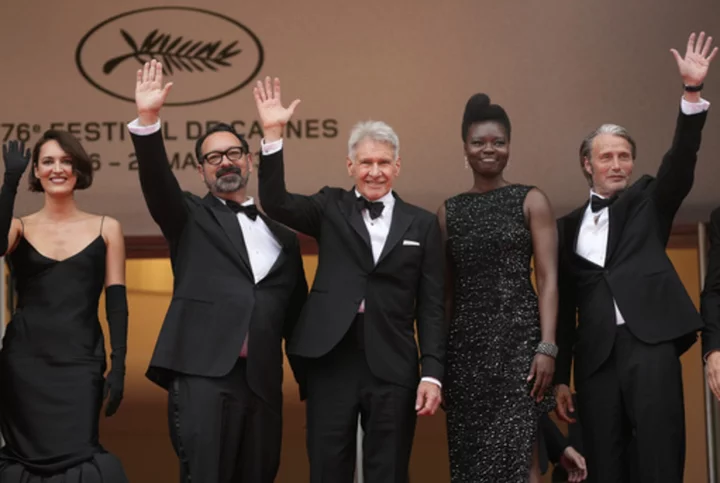SHENZHEN, China (AP) — In one painting, a child sits, mouth wide open, as a worker in white medical garb extends a long cotton swab toward her tonsils. In another, a masked officer and medical workers stand guard in front of an apartment cordoned off with ropes and seals reading “CLOSED,” as residents look on with frustration and despair.
These are some of the portraits that Zeng Fanzhi, 85, has painted to commemorate three years of China’s strict “zero-COVID” controls, which sparked nationwide protests a year ago. But Zeng, a retired architect living in Shenzhen, is not a critic of the measures, under which millions of people were tested, locked in apartments, or carried off to quarantine centers.
Zeng has spent much of his life in service to the Chinese state, designing monuments in Beijing’s Tiananmen Square and coal plants for the Ministry of Coal. He’s a member of Shenzhen’s state-sponsored artist’s association and his paintings feature on stamps and win prizes.
The artist has a different perspective from the young protesters — one shaped by early years in China living through war and revolution, and later years witnessing decades of prosperity and growth. To Zeng, China’s adherence to “zero-COVID” controls was necessary, and its people’s adherence to it heroic.
Chinese leader Xi Jinping “says that artistic creation must be from ‘The People’s Standpoint,’” Zeng says, explaining his focus on ordinary people. “This means art should reflect the reality of people's lives. The subjects of my paintings are aligned with this direction.”
___
Growing up, Zeng lived through some of the most tumultuous periods in Chinese history. Born to civil servants who fled for Chongqing, China’s wartime capital in World War II, Zeng grew up moving from city to city, fleeing the invading Japanese and the Chinese civil war that followed.
The Communist Party’s victory in 1949 ended decades of strife in China, bringing some stability to the country. Zeng aspired to be an artist and took art school entrance exams in 1957, but failed twice. His parents encouraged him to study architecture instead.
Soon after, the founder of Communist China, Mao Zedong, launched the Great Leap Forward, an ambitious but disastrous campaign to transform the impoverished country into an industrial power. Millions starved to death, and students across China spent time in political study sessions.
In 1962, fresh from college, Zeng was assigned to work for an architectural team in Beijing, designing stadiums and theaters around Tiananmen Square as well as the Avenue of Heavenly Peace.
A few years later, Zeng and his wife, a fellow architect, decided to move to Pingdingshan — home to one of the largest coalfields in China, nestled among mountains in the heart of the country.
There, for 20 years, they designed coal separation plants, from coal crushers to worker’s dorms.
By the 1980s, the couple was getting antsy. Mao had died and a new reformist leader, Deng Xiaoping, was in charge. China was opening up, and opportunity beckoned on the coasts. They begged to be relocated.
“We felt like we weren’t being put to our best use, so we want to jump ship,” Zeng said.
College graduates like them were in scarce supply, and jobs were easy to find. They moved to Shenzhen, an experimental economic zone located next to Hong Kong in China’s south. The ’90s saw China’s leaders experimenting with market capitalism, and Shenzhen was rapidly developing. Zeng began working at Shenzhen University, which back then was located in the distant suburbs and built among fields with muddy roads winding up to the entrance.
In the years that followed, Shenzhen boomed, and Zeng’s family prospered. Millions came to Shenzhen to work in factories that exported goods to overseas markets. Zeng and his wife designed dozens of Shenzhen’s apartments and office towers, which rose like reeds out of empty fields.
Newly affluent, they bought an apartment near the center of the city, while their children went overseas for study. Today, Shenzhen has more skyscrapers than New York or Tokyo.
"We’ve seen a lot of ups and downs in our life,” says his wife, Zhao Sirong. “Shenzhen was a fledging city, and we were pioneers.”
___
It wasn’t until Zeng turned 80 that he retired from architecture. Finally, Zeng was able to pursue his true passion: painting.
Despite his old-school training, he learned his new trade in a distinctly 21st-century fashion. Day by day, he watched tutorials of master artists online.
Zeng’s art is informed by socialist realism, a style he encountered growing up in Maoist China. He cites works by famed Russian realist painter Ilya Repin as inspiration, such as “Barge Haulers on the Volga," which shows 11 men dragging a barge, exhaustion on their faces. It’s an unflinching depiction of backbreaking labor, the quiet heroism of ordinary people in harsh conditions.
“It left a deep impression on me,” Zeng said.
Zeng found himself drawn to similar themes. One of his paintings, “Life is Not Easy," portrays a migrant worker bundled in scarves, selling vegetables and shivering as snow swirls around her.
Zhao, Zeng’s wife, complains about his rigorous painting routine. Zeng drives to his studio every morning, painting till late afternoon. The octogenarian works weekends, leaving his wife with only her plants to keep her company.
“What I want from my husband is that he walks slower and stops acting like a young man,” Zhao said, chuckling and sighing. “Why is he working so hard? I don't understand."
But Zhao still supports her husband's craft because she believes regular activity is key to preventing mental decline. They wonder at young people who spend their days idle, swiping endlessly on cellphone videos and whiling away their savings on outdoor games of mahjong in steamy Shenzhen.
“My life is still very fulfilling,” Zeng says. “Some say painting must be tiring for you. OK, sure, but is gambling tiring for you?”
___
As the coronavirus spread, Zeng was fascinated by how it upended daily life around him.
First he painted nurses swabbing residents, then children attending online classes. Then, last year, as controls grew strict and Zeng’s compound was locked down, he spent his days sitting on his balcony, painting residents locked in their complexes, guards standing sentry, and masked delivery drivers tossing groceries over fences.
“This was an unimaginable event that’s never happened before in the whole world,” Zeng says.
Zeng and his wife caught the virus last winter, when controls were abruptly lifted. Though his wife recovered quickly, Zeng spent weeks recuperating. Across China, hundreds of thousands perished as the infected overran hospitals and medication ran out of stock.
“We were all infected,” Zhao said. “We struggled through the past three years, and then things suddenly opened up. We weren't psychologically prepared."
Despite the pandemic’s historic nature, few depictions of the era exist in China outside official exhibits and state television glorifying the government’s role in combatting the virus. Under Xi, the state has tightened controls on artist expression, leading to some going overseas.
At a Beijing art exposition this fall, one of Zeng’s paintings was tucked away behind a column. The exposition, he said, deemed it too negative, as it depicted residents confined to their homes.
“We couldn’t put it on display,” he said with a chuckle, walking out of his booth and gesturing to the painting.
But Zeng sees his art as commemoration, not criticism. He lived through a “great historical event," he says, and he sees his artwork as an observation honoring all the sacrifice and difficulty endured by ordinary people.
For Zeng and Zhao, their government benefits — including public medical care, subsidized food, free public transit, and a pension of 10,000 yuan ($1,400) a month — is well beyond what they imagined having when they were younger, growing up in a China scarred by war.
“We understand the country’s measures,” Zhao says. “We all feel that on the whole, our policy was correct, because if we reopened too early, it could have been like the United States, where the death rate was very high.”
Today, Zeng is hard at work on a new series portraying Chinese leader Xi Jinping, which he hopes will serve as positive “political promotion”. His latest depicts Xi sitting humbly among villagers. He tentatively calls it, “Chairman Xi Taking Us on the Road to Prosperity.”
“My work can play a role in promoting the superiority of our distinctive socialist system," Zeng says. “Our current era is a great era, and I want to paint paintings that capture this era."

